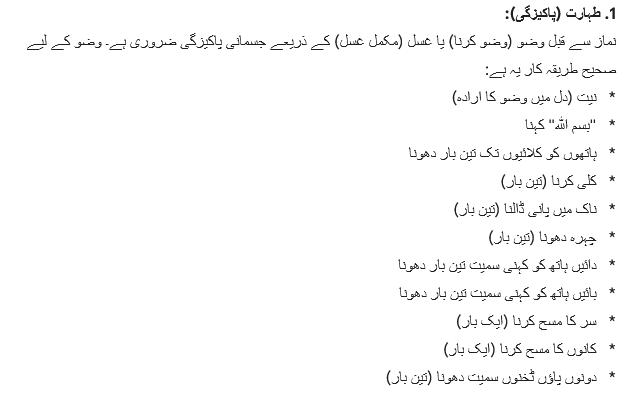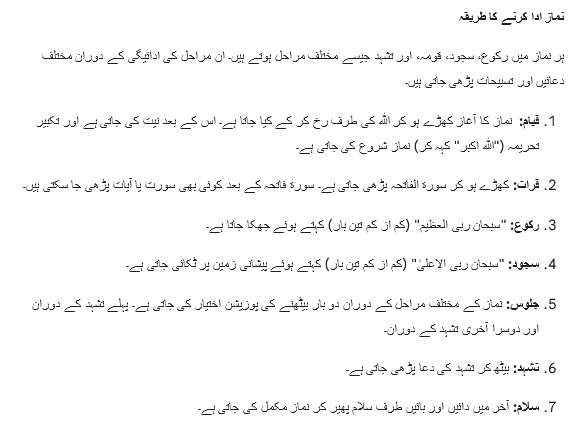Namaz Ka Tarika in Urdu
Today just we will discuss Namaz Ka Tarika in Urdu. Namaz, one of the five pillars of Islam, holds a central position in the life of a Muslim. It serves as a spiritual connection with Allah, providing tranquility and contentment by removing the believer from worldly worries. Understanding the correct way to perform Namaz is essential for every Muslim. Let’s understand the step-by-step process of performing Namaz.

Preparation for Namaz
Taharah (Purity):
Physical purity is essential before Namaz, achieved through Wudu (ablution) or Ghusl (complete bath). The correct procedure for Wudu is:
- Niyyah (Intention to perform Wudu in the heart)
- Saying “Bismillah”
- Washing hands up to the wrists (three times)
- Rinsing the mouth (three times)
- Cleaning the nose (three times)
- Washing the face (three times)
- Washing the right arm including the elbow (three times)
- Washing the left arm including the elbow (three times)
- Wiping the head (once)
- Wiping the ears (once)
- Washing both feet up to the ankles (three times)

Dress:
It is necessary to wear appropriate clothing for Namaz, both for men and women. For men, the area from the navel to the knees should be covered, while for women, it is necessary to cover the entire body except for the face and hands.
Facing the Qiblah:
It is necessary to face the Qiblah (Kaaba) for the performance of Namaz. You can determine the direction of the Qiblah by looking at a Qibla compass or the direction of the mosque.
The Five Daily Prayers
Namaz is obligatory five times a day in Islam: Fajr, Zuhr, Asr, Maghrib, and Isha. The time and number of Rakats (units of prayer) vary for each prayer.
| Name of Prayer | Time | Obligatory Rakats |
| Fajr | From dawn till before sunrise | 2 |
| Zuhr | After the sun starts to decline from its zenith | 4 |
| Asr | When the shadow of an object becomes equal to its length | 4 |
| Maghrib | After sunset until the redness disappears | 3 |
| Isha | After the redness of the sky disappears completely | 4 |
How to Perform Namaz
Each prayer consists of different stages like Ruku (bowing), Sajdah (prostration), Qaumah (standing), and Tashahhud (sitting). Different supplications and Tasbihat (phrases glorifying Allah) are recited during these stages.
- Qiyaam (Standing): Namaz begins by standing and facing the Qiblah. Niyyah (intention) is made, and the prayer starts with Takbir Tahrimah (saying “Allahu Akbar”).
- Qira’at (Recitation): Surah Al-Fatihah is recited while standing. After Surah Fatihah, any other Surah or verses can be recited.
- Ruku (Bowing): Bowing is performed while saying “Subhana Rabbiyal Azeem” (at least three times).
- Sajdah (Prostration): Prostration is performed by placing the forehead on the ground while saying “Subhana Rabbiyal A’la” (at least three times).
- Julus (Sitting): The sitting position is adopted twice during the prayer. First, during the first Tashahhud, and second, during the last Tashahhud.
- Tashahhud: The Tashahhud supplication is recited while sitting.
- Salam: Finally, Namaz is completed by turning the head to the right and left while saying Salam.
Special Prayers and Occasions
- Friday Prayer (Jumu’ah)
- Eid prayers (Eid al-Fitr and Eid al-Adha)
- Taraweeh (during Ramadan, after Isha)
Virtues and Benefits of Namaz
- Forgiveness of sins
- A means of entering Paradise
- Guarantee of success in this world and the hereafter
- Spiritual purification and tranquility
- Beneficial for physical health
Namaz is the most important part of a Muslim’s life. It is a spiritual journey that brings us closer to Allah and fills our hearts with peace. Therefore, we should make Namaz a regular part of our lives and strive to perform it correctly. May Allah accept our prayers. Ameen.






